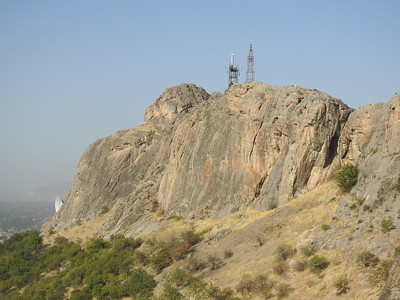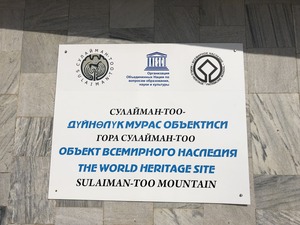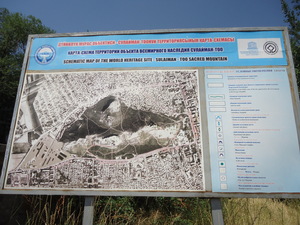Sulaiman-Too

Sulaiman-Too Sacred Mountain is a sacred mountain originating from pre-Islamic times.
The cult practices for mountain worship have been continuing here for thousands of years, and have been absorbed by Islam. The mountain has a height of ca. 200m and overshadows the city of Osh. On it, Stone and Bronze Age settlements, petroglyphs, ritual sites and Islamic buildings can be found.
Community Perspective: the walk on the network of traditional pilgrim paths is considered enjoyable, and you will meet many locals doing their daily rounds and seek for blessings. However, the Soviet-style museum carved into the mountain is disturbing and the petroglyphs are damaged by graffiti.
Map of Sulaiman-Too
Community Reviews
Els Slots

Sulaiman-Too is the landmark of the lovely city of Osh. It is a mostly relict cultural landscape of a sacred mountain – so much was destroyed during the Soviet-communist period of Kyrgyzstan, that really only the caves and the legends remain. A few recently revived or added Islamic buildings can be found at the foot of the mountain, outside the gates, including the pretty, Arab-sponsored Sulaiman-Too Mosque dating from 2012.
Accurate information on how to visit the mountain is surprisingly rare to find. One can actually enter from two sides: where the English language sources seem to steer you to the steep stairs from Kurmanjan Datka Street, the locals generally use the winding way up from Gapar Aytiev. A handy overview map and a larger car parking can be found at that entrance.
There’s a fence fully encircling the mountain, I guess to avoid rough sleepers. A 20 Som entrance fee is only levied from 9 a.m. onwards: there’s a ticket kiosk at either entrance. I entered at 8.45 and found the gate open. I also encountered people coming from the other side, they must have been on their way from around 8. So I guess opening hours are between 8 a.m. and sunset.
Local people seem to do this walk along the ridge of the mountain as a daily exercise. The easy path has an iron railing and is largely made of cement. Here and there you can still see the original pilgrim's path: worn, marble-like stone which is a bit slippery to walk on.
I sat for a while on a strategically placed bench in front of two sacred sites: Beshikene and the Tamchy Tamar cave. Two local women eventually arrived, dressed in popular floral dresses. They kicked off their shoes at the cave and crawled inside. It turned out that the cave is so deep that two adult women can disappear completely out of sight. They went in there to pray: the drops of rainwater falling from the ceiling would make blindness and other eye problems disappear.
Further down the path, you pass two larger caves, which are located in two of the other peaks. These can only be reached via an uphill sandy path. You aren’t allowed to go in there. Around the corner lies the infamous museum, built into the largest cave during Soviet times, destroying its sacred function. Originally it even served as a restaurant, it has only been a museum since 2000. There are some pots, pans, traditional costumes, and stuffed animals to see. Not really worth the 150 Som entrance fee. Walking down further along the path, you’ll reach the other entrance/exit. Here you can find some excavations from the Bronze Age.
Even sadder than the museum is the fate of the petroglyphs. Most of them are located near the Kurmanjan Datka entrance: don’t go up the stairs, but follow the flat path to the left. There is so much graffiti that the old drawings can hardly be distinguished anymore. The photos in the nomination file show them as white drawings (probably colored white later to make them more visible), often displaying circles and rakes. I found a few, which may have been historic ones or later emulations. There are a lot of warning signs at the mountain (Don’t write on the rocks! Don’t enter the caves!), but there is still little oversight. I only encountered one security guy, next to the House of Babur at the first peak.
Read more from Els Slots here.
Juha Sjoeblom

Site visited April 2014. Osh was the last stop on my tour in Kazakhstan and Kyrgyzstan. In Osh I wanted to see what the Sulaiman-Too or Sulayman Mountain is all about. In retrospect, one of the most memorable things on this whole tour was the actual journey from Bishkek to Osh. It is also one of my fondest travel memories.
In Bishkek I hopped on a Osh bound marshrutka. At first I waited for two hours for minivan to get full. The driver told that the journey would last nine hours but it ended to be an excruciating 13 hours. There were stunning views when we drove through the passes and up to the mountains. It was exiting to travel with six Kyrgyz who didn't share any common language with me. Along the road we stopped in some restaurants and also in one home. In the middle of the night the driver played music on car stereo so loud that I couldn’t sleep at all. But the music didn’t seem to bother a Kyrgyz granny who snored on the front seat. After a sleepless night it was a relief when I saw Sulaiman-Too in the horizon at six o’clock in the morning.
I had one whole day in Osh and that was a good one. Despite of being somewhat Sovietized, Osh is a city with a real Central Asian feel with its lively atmosphere and bustling bazaars. Sacred Mountain is the centerpiece of this old Silk Road city. It is very impressive looking from the long distance because the surrounding areas of Fergana Valley are quite flat. You can see the mountain almost everywhere in Osh.
It was really nice to walk slowly on a network of traditional pilgrim paths. The mountain offers nice views to the roofs of Osh. There were lots of local people walking around and enjoying the sceneries. There were also women who ascend to the mountain in order to get pregnant and give birth to healthy children. I spent three hours wandering around the mountain.
The mountain is surrounded by muslim cemeteries. In Sulaiman-Too there are totally five peaks. On the easternmost peak there is a small mosque called Babur’s house. The original building from 16th century has been destroyed in the 1960s by Soviet administration and rebuilt in the 80s. On the eastern base there are two other old and renovated mosques. On the south side there is a huge new mosque. Numerous caves seemed to be a popular hiding places for local young couples. In many places you can see rock carvings, both old petroglyphs and also newer ones from the Soviet times.
One thing that disturbed me was the museum which was carved actually inside the mountain. It was weird to see that Soviet style concrete arch sticking out from the rock. In my opinion it reduces the authenticity of the site. Otherwise the small museum was OK and worth a short visit.
In all, Sulaiman-Too is one of few worth noticing cultural sites in Kyrgyzstan, the country which is better known for its natural sights. I found visiting this site very enjoyable and it was a nice ending to my tour in Central Asia.
Adrian Lakomy
Visited during a sunny day in April.
The site is located in city Osh not far from the border with Uzbekistan. The site in fact are five linked hills in the middle of the city. The city is located in a flat area so the Sulaiman-too is visible from far away.
The hills itself are quite steep, so you have to climb a bit.
This hill is sacred and it is still used as a place of worship on various places in the area. Most famous is a stone where you have to slide down if you want to heal your back. There are various places for other healing - arms, eyes and other illnesses
Beneath the hill is a huge mosque and an Islamic cemetery. On the top of the hill there is a small mosque linked to first Mughal - Babur.
The petroglyphs are in danger by the people who are covering them by graffiti.
There are various caves, which can be visited.
I visited two museums in site - both are interesting, majority of the descriptions are in russian.
It was a nice experience to visit the site, as it is a living site with full of pilgrims or people seeking healing.
I enjoyed the stay, as well to see the city of Osh with its bazaar.
Community Rating
- : Nongbulinqing Rahelka
- : Mihai Dascalu Rvieira
- : Xiquinho Silva Adrian Turtschi
- : Els Slots Milan Jirasek Philipp Leu Adrian Lakomy
- : Alexander Lehmann Hanming Juha Sjoeblom
- : George Evangelou Solivagant Ivan Rucek Jon Opol Walter Sophie Martina Rúčková
- : Wojciech Fedoruk Szucs Tamas Richard Stone David Marton Jakubmarin
- : Mikko
- : Yevhen Ivanovych
Site Info
- Full Name
- Sulaiman-Too Sacred Mountain
- Unesco ID
- 1230
- Country
- Kyrgyzstan
- Inscribed
- 2009
- Type
- Cultural
- Criteria
-
3 6
- Categories
- Cultural Landscape - Relict
- Link
- By ID
Site History
2009 Inscribed
2008 Referred
Threats to the site (aerial ropeway, mosque, housing)
2007 Referred
WHC recommends to complete management plan and protection, extend the buffer zone and put in place a tourism strategy.
Site Links
Unesco Website
Official Website
Related
In the News
Connections
The site has 24 connections
Art and Architecture
Constructions
History
Human Activity
Individual People
Religion and Belief
Timeline
Trivia
WHS Names
World Heritage Process
Visitors
81 Community Members have visited.
The Plaque
 (photo by Els)
(photo by Els) (photo by Jarek)
(photo by Jarek)